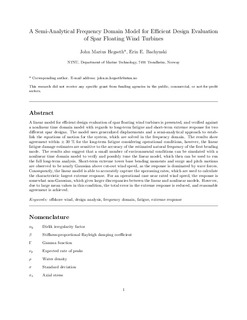| dc.contributor.author | Hegseth, John Marius | |
| dc.contributor.author | Bachynski, Erin Elizabeth | |
| dc.date.accessioned | 2019-11-13T11:59:00Z | |
| dc.date.available | 2019-11-13T11:59:00Z | |
| dc.date.created | 2019-04-30T12:02:01Z | |
| dc.date.issued | 2019 | |
| dc.identifier.citation | Marine Structures. 2019, 64 186-210. | nb_NO |
| dc.identifier.issn | 0951-8339 | |
| dc.identifier.uri | http://hdl.handle.net/11250/2628212 | |
| dc.description.abstract | A linear model for efficient design evaluation of spar floating wind turbines is presented, and verified against a nonlinear time domain model with regards to long-term fatigue and short-term extreme response for two different spar designs. The model uses generalized displacements and a semi-analytical approach to establish the equations of motion for the system, which are solved in the frequency domain. The results show agreement within ± 30% for the long-term fatigue considering operational conditions, however, the linear fatigue damage estimates are sensitive to the accuracy of the estimated natural frequency of the first bending mode. The results also suggest that a small number of environmental conditions can be simulated with a nonlinear time domain model to verify and possibly tune the linear model, which then can be used to run the full long-term analysis. Short-term extreme tower base bending moments and surge and pitch motions are observed to be nearly Gaussian above cut-out wind speed, as the response is dominated by wave forces. Consequently, the linear model is able to accurately capture the upcrossing rates, which are used to calculate the characteristic largest extreme response. For an operational case near rated wind speed, the response is somewhat non-Gaussian, which gives larger discrepancies between the linear and nonlinear models. However, due to large mean values in this condition, the total error in the extreme response is reduced, and reasonable agreement is achieved. | nb_NO |
| dc.language.iso | eng | nb_NO |
| dc.publisher | Elsevier | nb_NO |
| dc.rights | Attribution-NonCommercial-NoDerivatives 4.0 Internasjonal | * |
| dc.rights.uri | http://creativecommons.org/licenses/by-nc-nd/4.0/deed.no | * |
| dc.title | A semi-analytical frequency domain model for efficient design evaluation of spar floating wind turbines | nb_NO |
| dc.type | Journal article | nb_NO |
| dc.type | Peer reviewed | nb_NO |
| dc.description.version | acceptedVersion | nb_NO |
| dc.source.pagenumber | 186-210 | nb_NO |
| dc.source.volume | 64 | nb_NO |
| dc.source.journal | Marine Structures | nb_NO |
| dc.identifier.doi | 10.1016/j.marstruc.2018.10.015 | |
| dc.identifier.cristin | 1694731 | |
| dc.description.localcode | © 2018. This is the authors’ accepted and refereed manuscript to the article. Locked until 20.11.2020 due to copyright restrictions. This manuscript version is made available under the CC-BY-NC-ND 4.0 license http://creativecommons.org/licenses/by-nc-nd/4.0/ | nb_NO |
| cristin.unitcode | 194,64,20,0 | |
| cristin.unitname | Institutt for marin teknikk | |
| cristin.ispublished | true | |
| cristin.fulltext | postprint | |
| cristin.qualitycode | 2 | |

